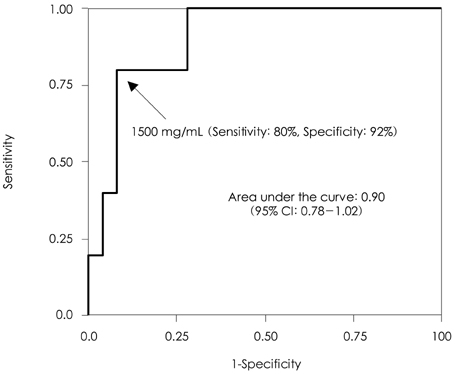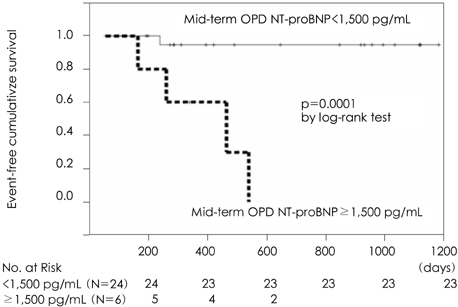Korean Circ J.
2007 May;37(5):202-207. 10.4070/kcj.2007.37.5.202.
N-terminal Pro B-type Natriuretic Peptide Predicts Cardiac Events in Discharged Patients with Idiopathic Dilated Cardiomyopathy
- Affiliations
-
- 1Division of Cardiology, Cardiac and Vascular Center, Department of Medicine, Samsung Medical Center, Sungkyunkwan University School of Medicine, Seoul, Korea. eunseok.jeon@samsung.com
- KMID: 2227065
- DOI: http://doi.org/10.4070/kcj.2007.37.5.202
Abstract
-
BACKGROUND AND OBJECTIVES: Heart failure is a progressive chronic disease with high morbidity and mortality. The aim of this study was to determine whether the N-terminal pro B-type natriuretic peptide (NT-proBNP) levels in the blood can predict readmission due to heart failure or cardiac death (cardiac event) following hospital discharge, and if these are a better predictive marker than a pre-discharge echocardiogram or other laboratory parameters in discharged patients with idiopathic dilated cardiomyopathy (DCM).
SUBJECTS AND METHODS
The outcomes of 36 patients with idiopathic DCM, diagnosed on hospital admission, were retrospectively evaluated.
RESULTS
During a mean follow-up period of 520 days, a 22.2% rate of cardiac events was observed. Evaluation of the NT-proBNPs showed the mid-term (mean 84th day after discharge) outpatient (OPD) NT-proBNP levels to be a strong predictor of cardiac events, with an area under the curve analysis of 0.90. The optimal mid-term OPD NT-proBNP cut-off level for predicting cardiac events was 1500 pg/mL, with a sensitivity and specificity of 80 and 92%, respectively; patients with levels above this threshold had a 22.9 hazard ratio for cardiac events compared to those with levels below this threshold.
CONCLUSION
The mid-term OPD plasma NT-proBNP levels were able to predict cardiac events in discharged patients with idiopathic DCM, regardless of the admission or pre-discharge NT-proBNP levels and other laboratory parameters. The measurement of OPD NT-proBNP at the mid term follow-up may be useful in outpatient therapeutic monitoring or for the development of prognostic guidelines in patients with idiopathic DCM.
Keyword
MeSH Terms
Figure
Reference
-
1. Braunwald E. Shattuck lecture: cardiovascular medicine at the turn of the millennium: triumphs, concerns, and opportunities. N Engl J Med. 1997. 337:1360–1369.2. Rich MW, Beckham V, Wittenberg C, Leven CL, Freedland KE, Carney RM. A multidisciplinary intervention to prevent the readmission of elderly patients with congestive heart failure. N Engl J Med. 1995. 333:1190–1195.3. McDermott MM, Feinglass J, Lee PI, et al. Systolic function, readmission rates, and survival among consecutively hospitalized patients with congestive heart failure. Am Heart J. 1997. 134:728–736.4. McMurray JJ, Stewart S. Epidemiology, aetiology, and prognosis of heart failure. Heart. 2000. 83:596–602.5. Han SW, Ryu KH, Chae SC, et al. Multicenter analysis of clinical characteristics and prognostic factors of patients with congestive heart failure in Korea. Korean Circ J. 2005. 35:357–361.6. Levin ER, Gardner DG, Samson WK. Natriuretic peptides. N Engl J Med. 1998. 339:321–328.7. Hall C. Essential biochemistry and physiology of (NT-pro) BNP. Eur J Heart Fail. 2004. 6:257–260.8. Tsutamoto T, Wada A, Maeda K, et al. Attenuation of compensation of endogenous cardiac natriuretic peptide system in chronic heart failure: prognostic role of plasma brain natriuretic peptide concentration in patients with chronic symptomatic left ventricular dysfunction. Circulation. 1997. 96:509–516.9. Omland T, Persson A, Ng L, et al. N-terminal pro-B-type natriuretic peptide and long-term mortality in acute coronary syndromes. Circulation. 2002. 106:2913–2918.10. Baek KK, Jeon ES, Rhee I, et al. N-terminal pro-B-type natriuretic peptide as a prognostic marker in acute coronary syndrome. Korean Circ J. 2004. 34:1070–1081.11. Chung IH, Yoo BS, Ryu HY, et al. The relationship between the early follow-up BNP level and congestive status or prognosis in acute heart failure. Korean Circ J. 2006. 36:200–207.12. Logeart D, Thabut G, Jourdain P, et al. Predischarge B-type natriuretic peptide assay for identifying patients at high risk of re-admission after decompensated heart failure. J Am Coll Cardiol. 2004. 43:635–641.13. Drazner MH, Rame JE, Stevenson LW, Dries DL. Prognostic importance of elevated jugular venous pressure and a third heart sound in patients with heart failure. N Engl J Med. 2001. 345:574–581.14. Rauchhaus M, Clark AL, Doehner W, et al. The relationship between cholesterol and survival in patients with chronic heart failure. J Am Coll Cardiol. 2003. 42:1933–1940.15. Forman DE, Butler J, Wang Y, et al. Incidence, predictors at admission, and impact of worsening renal function among patients hospitalized with heart failure. J Am Coll Cardiol. 2004. 43:61–67.16. Anand I, McMurray JJ, Whitmore J, et al. Anemia and its relationship to clinical outcome in heart failure. Circulation. 2004. 110:149–154.17. Solomon SD, Anavekar N, Skali H, et al. Influence of ejection fraction on cardiovascular outcomes in a broad spectrum of heart failure patients. Circulation. 2005. 112:3738–3744.18. Grayburn PA, Appleton CP, DeMaria AN, et al. Echocardiographic predictors of morbidity and mortality in patients with advanced heart failure. J Am Coll Cardiol. 2005. 45:1064–1071.19. Yeo KT, Wu AH, Apple FS, et al. Multicenter evaluation of the Roche NT-proBNP assay and comparison to the Biosite Triage BNP assay. Clin Chim Acta. 2003. 338:107–115.20. Seino Y, Ogawa A, Yamashita T, et al. Application of NT-proBNP and BNP measurements in cardiac care: a more discerning marker for the detection and evaluation of heart failure. Eur J Heart Fail. 2004. 6:295–300.21. Hartmann F, Packer M, Coats AJ, et al. Prognostic impact of plasma N-terminal pro-brain natriuretic peptide in severe chronic congestive heart failure. Circulation. 2004. 110:1780–1786.22. Gardner RS, Ozalp F, Murday AJ, Robb SD, McDonagh TA. N-terminal pro-brain natriuretic peptide: a new gold standard in predicting mortality in patients with advanced heart failure. Eur Heart J. 2003. 24:1735–1743.23. Kirk V, Bay M, Parner J, et al. N-terminal proBNP and mortality in hospitalised patients with heart failure and preserved vs. reduced systolic function. Eur J Heart Fail. 2004. 6:335–341.24. Bettencourt P, Azevedo A, Pimenta J, Frioes F, Ferreira S, Ferreira A. N-terminal-pro-brain natriuretic peptide predicts outcome after hospital discharge in heart failure patients. Circulation. 2004. 110:2168–2174.25. Felker GM, Thompson RE, Hare JM, et al. Underlying causes and long-term survival in patients with initially unexplained cardiomyopathy. N Engl J Med. 2000. 342:1077–1084.26. Wynne J, Braunwald E. Zipes DP, Libby P, Bonow RO, Braunwald E, editors. The cardiomyopathies. Braunwald's Heart Disease: a textbook of cardiovascular medicine. 2005. 7th ed. Philadelphia: Elsevier Saunders Company;1659–1696.27. Troughton RW, Frampton CM, Yandle TG, Espiner EA, Nicholls MG, Richards AM. Treatment of heart failure guided by plasma aminoterminal brain natriuretic peptide (N-BNP) concentrations. Lancet. 2000. 355:1126–1130.28. Richards M, Troughton RW. NT-proBNP in heart failure: therapy decisions and monitoring. Eur J Heart Fail. 2004. 6:351–354.29. Werner GS, Schaefer C, Dirks R, Figulla HR, Kreuzer H. Prognostic value of Doppler echocardiographic assessment of left ventricular filling in idiopathic dilated cardiomyopathy. Am J Cardiol. 1994. 73:792–798.30. Pinamonti B, Zecchin M, di Lenarda A, Gregori D, Sinagra G, Camerini F. Persistence of restrictive left ventricular filling pattern in dilated cardiomyopathy: an ominous prognostic sign. J Am Coll Cardiol. 1997. 29:604–612.
- Full Text Links
- Actions
-
Cited
- CITED
-
- Close
- Share
- Similar articles
-
- Clinical Implication of B-type Natriuretic Peptide in the Elderly
- Biomarkers in Heart Failure: Focus on B-type Natriuretic Peptide
- Changes in N-terminal pro-B-type natriuretic peptide in a neonate with symptomatic isolated left ventricular noncompaction
- N-terminal Pro-B-type Natriuretic Peptide as a Predictive Risk Factor in Fontan Operation
- Hemodynamics and Left Ventricular Cineangiographic Findings in Idiopathic Dilated Cardiomyopathy



